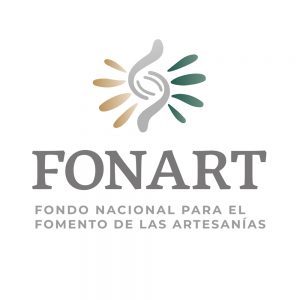National Fund for the Development of Arts and Crafts
FONART
The Fondo Nacional para el Fomento de las Artesanías or National Fund for the Development of Arts and
Crafts (best known as FONART) is a dependence of the Secretariat of Social Development (SEDESOL). This fund was established in 1974 in order to promote and protect traditional Mexican handcrafts. This agency has four main programs including retail selling, artisan training, and the sponsoring of several craft competitions held on a local, regional and national level. FONART has directly helped thousands of artisans since its creation. FONART currently seeks the capacity to authenticate crafts on a national and international level due to competing imitation products from Asia.
Purpose
Since 1995, FONART has been under the supervision in Mexico from the Secretariat of Social Development (SEDESOL). The overall purpose of this entity is to protect and promote traditional Mexican handcrafts and its other purpose is opening national and international markets for craftsmen. Most of these craftsmen live on poor, rural and indigenous areas. It is estimated that there are 8 million artisans working in Mexico, and FONART directly helped more than 25,000 of these artisans back in 2006. Those who live in impoverished or indigenous areas have priority within this fund. Back in 2007, the agency had a budget (in pesos) of 71 million, of which 42 million pesos were generated by sales of crafts.
Main Programs
FONART has four different programs to promote and benefit Mexican handcrafts. These diverse programs involve artisan training, technical assistance, financing, craft competitions and a government buying program.
Training is offered to help artisans improve the quality and design of their hand crafted products, while
maintaining traditional cultural elements as well as making production techniques more
environmentally friendly. There are grants which are available and are awarded to qualified individuals or organized groups mostly as an alternative to traditional banking methods. Annual regional competitions are held to honor artisans who have excelled in their craft and also to honor those who stand out in areas such as innovation and the preservation and rescue of traditional techniques. These competitions are held at a local, state and national levels. The winning pieces from these competitions are then considered to be high-value items.
FONART also has a buying program where pieces are purchased directly from artisans at regional centers or via agents that travel to craft areas periodically. FONART also buys pieces from different state-run institutions that promote crafts. The acquisition system has five storage centers in Mexico located in the states of Jalisco, Michoacán, Oaxaca, San Luis Potosí and Mexico City.
Craft Competitions
FONART sponsors many crafts competitions on different occasions in various regions of Mexico. These competitions are created with the purpose of promoting the sale and quality of the crafts produced. This function is under control of the Departmento de Concursos. The purses for first prize offered at these competitions may vary from 10,000 to 100,000 pesos.
In the state of Guerrero alone, competitions include the following:
- Pintores de Alto Balsas (Folk Painting on Amate Paper) in Xalitla
- Concurso de Hilado y Tejido del Huipil (Huipil) in Metlatónoc
- Concurso de Alfarería con Engobes Minerales (Pottery) in San Agustín Oapan
- Concurso de Laca Artesanal (Lacquered Items) of Temalcatzingo
- Concurso Municipal de Joyería (Jewelry)
- Concurso Regional de la Costa Chica
- Concurso de Laca (Lacquered Items) in Olinalá
- Concurso Nacional de la Feria de la Plata (Silverwork) in Taxco
The last competition is held on a national level. The hand crafted pieces of artwork presented during the competition are judged on several criteria. They are judged on design, technique, materials used in its production and if the piece represents an ethnic culture from Mexico. One other factor is if the piece uses a sustainable resource.
Retail Stores
Fairs and markets are key outlets for Mexican crafts but unfortunately they are not sufficient to promote the hand crafted products from Mexico. The agency runs several retail stores, all of which are in Mexico City with the exception of one retail store in San Luis Potosí. Of all the hand crafted items for sale, the best-selling items are ceramics, lacquered items and glasswork. Most of these products come from Oaxaca, Chiapas and Michoacan. In contrast to most other craft outlets, crafts at the FONART
stores are more upscale and there’s more variation. The FONART stores have reached sales of over 2.5 million pesos per year. However, one problem that FONART stores have had is that most of the stores are situated in non-tourist venues. Recently though, the agency has begun to work with the federal Secretariat of Tourism in order to find more ways to sell to international tourists as well as use crafts as attract tourists to rural areas.
Annual FONART Exhibition
FONART and other agencies sponsor a yearly exhibition and bazaar that travels around the country of Mexico. In 2010, the theme based on the twin celebrations of the bicentennial of Mexico’s Independence and the Centennial of the Mexican Revolution. The offering of crafts by vendors at this event was quite varied with representatives from all Mexican states as well as the Federal District of Mexico City. During this exhibition, there were about 500 art pieces deemed to be the most representative of Mexican crafts.
Efforts to Protect Mexican Crafts
Another effort by FONART concerns the protection of Mexican handcrafts from cheaper international imports, especially those from China and other parts of Asia. FONART has requested that the Mexican Congress give them the right to fine companies that import Asian imitations of Mexican crafts. Another important proposal is to register regional and craft trademarks to ensure that genuine Mexican crafts are marked as such at the national and international levels. Currently, thirty three crafts have this type of trademark at the state level. These include the crafts made in Oaxacan locales such as San Bartolo Coyotepec, Santo Tomás Jalietza, Teotitlán del Valle and San Martín Tilcajete.
